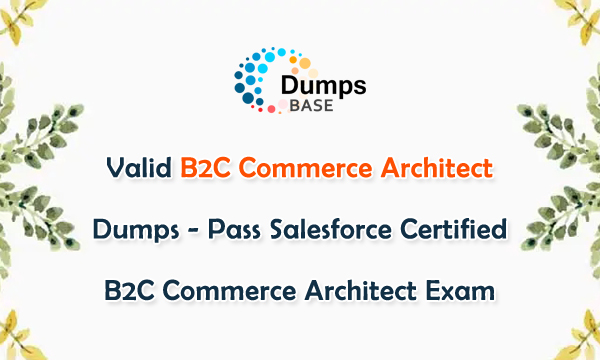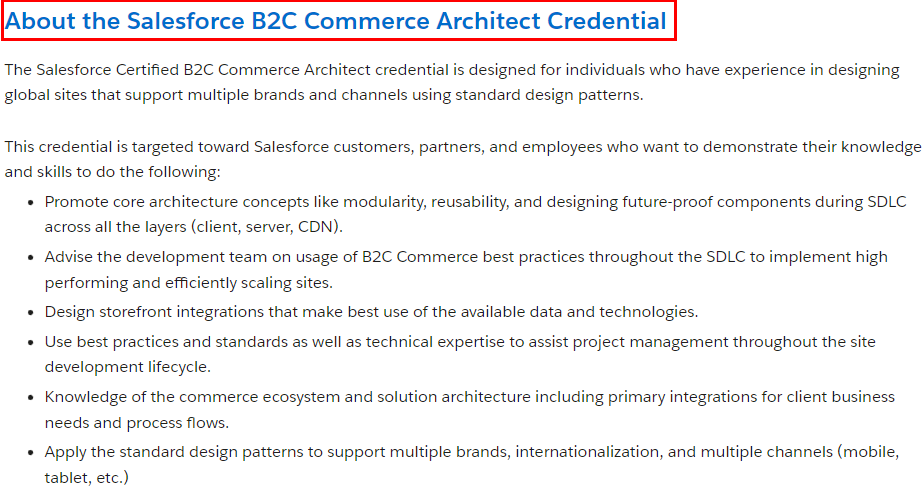Valid B2C Commerce Architect Dumps - Pass Salesforce Certified B2C Commerce Architect Exam
Good for all Salesforce B2C Commerce Architect exam candidates, the valid B2C Commerce Architect dumps are available at DumpsBase for your preparation for the Salesforce Certified B2C Commerce Architect certification exam. The Salesforce B2C Commerce Architect dumps contain 76 practice exam questions and answers, which are extremely effective to explore your abilities for Salesforce Certified B2C Commerce Architect exam preparation. We promise that the valid B2C Commerce Architec dumps can assist you really properly. Just come to DumpsBase to download the B2C Commerce Architect dumps pdf file to start learning all the valid questions and correct answers before attending the Salesforce Certified B2C Commerce Architect exam. The B2C Commerce Architect dumps questions in pdf format are exceptionally useful and straightforward to take for anyone. We ensure that you can pass the B2C Commerce Architect exam.

Why do so many candidates choose to pass the Salesforce B2C Commerce Architect exam?
B2C Commerce Architect is a Salesforce Architect exam, which is designed for individuals who have experience in designing global sites that support multiple brands and channels using standard design patterns. There are many candidates choosing to pass the Salesforce Certified B2C Commerce Architect certification exam. It is a popular Salesforce Architect exam, which is targeted toward Salesforce customers, partners, and employees who want to demonstrate their knowledge and skills to do the following in the picture:

How to earn the Salesforce B2C Commerce Architect Credential?
To earn the Salesforce B2C Commerce Architect credential, you must meet the following requirements:
● Have five or more years of eCommerce experience
● Hold the current Salesforce B2C Commerce Developer certification as the prerequisite
● Pass the B2C Commerce Architect exam
The actual B2C Commerce Architect exam contains 60 multiple-choice/multiple-select questions and 2 non-scored questions, candidates will have 105 minutes to answer all these questions. The passing score should be 65%. It measures your knowledge and skills related to the following objectives:
■ Design/Discovery: 29%
■ Build: 19%
■ Monitoring/Troubleshooting: 14%
■ Integrations and Customizations: 22%
■ Launch: 16%
There are three classes recommended to complete the Salesforce B2C Commerce Architect certification:
▲ Architect B2C Commerce Solutions (ARC300)
▲ Manage and Merchandise a B2C Commerce Cloud Storefront (CCM101)
▲ B2C Commerce Developer with SFRA (CCD102)
More, the valid B2C Commerce Architect dumps are also highly recommended by DumpsBase to prepare for the Salesforce Certified B2C Commerce Architect exam. The B2C Commerce Architect dumps of DumpsBase offer you the correct questions and answers for good preparation. As the top B2C Commerce Architect study materials, DumpsBase helps to evaluate your skills that happen to be an absolute necessity for getting a Salesforce Architect certification. Upgrade your capabilities and get the B2C Commerce Architect dumps questions and answers. You can read B2C Commerce Architect free dumps to check the valid B2C Commerce Architect dumps:
Your project requires the integrating with a 3rd party PIM for importing master catalog, two storefront catalogs and pricebooks. All imports need to happen in a single job. Search indexes will also need to be re-built.
A. Two flows are needed. First flow will execute in parallel under organization scope the master catalog import and then the storefront catalogs and on the other hand in parallel the pricebooks imports. Then new flow will be needed with site scope to perform site reindex.
B. Two flows are needed. First flow will execute in parallel under site scope the master catalog import and then the storefront catalogs and on the other hand in parallel the pricebooks imports. Then new flow will be needed with site scope to perform site reindex.
C. Three flows are needed. First to import master and storefront catalogs (organization scope). Another job flow with site scope to import pricebooks and another to perform site reindex under site scope.
D. Two flows are needed. First will execute in parallel under organization scope the master catalog import and then the other flow with storefront catalog import and pricebooks (sequential) organization scope. The second flow will be needed with site scope to perform site reindex.
Answer: A
You’re in charge of Pipeline migration to Controllers.
What should be the best approach to do it in order to avoid poor performance and using Pipelines and controllers together until all migration is done?
A. Use the same name for new Controllers than pipelines because it will be easy to identify that is migrated and Controllers take precedence. Furthermore it will be a good practice to do it in separate cartridges.
B. To reduce risk of circular dependencies and for easier migration mix pipelines and controllers in a single cartridge.
C. onRequest and onSession pipelines are replaced with the OnRequest and OnSession hooks.
D. Controllers and pipelines must be in the same folder to avoid collisions between them.
Answer: A, C
Facebook connect will be available on your storefront to allow users to log in. To configure properly the new OAuth provider.
What should you need from your product owner?
A. User and password from Facebook to get the access token.
B. Ask for the access token.
C. Ask to grant needed permissions for your facebook user.
D. Send request to facebook endpoint with app_id sended by POST to retrieve the oauth token.
Answer: C
Your project has 4 storefronts for different branches. Everyday at 4.00 am runs a job to import inventories, master catalog and storefronts for each of those sites. You’re in charge of job configuration, given this information what should be the best approach to achieve it?
A. First flow with organization scope to import master catalog, another flow with 4 steps to import each storefront catalog with site scope and in parallel inventory import with organization scope.
B. None of these answers are correct
C. 2 flows needed. First one to import master catalog with organization scope and in parallel import storefronts with site scope and second flow to import the inventory with organization scope.
D. 3 flows are needed. First master catalog with organization scope. Second flow is to import storefront catalogs with site scope and last to import inventory with organization scope.
Answer: A
As a Commerce Architect you should ensure that the cache hit ratio for your storefront is over 70%. During your investigation you realize that a significant number of pages are not cached.
From which tool can you get this information?
A. Page Speed
B. Google Lighthouse
C. Code Profiler
D. Pipeline Profiler
E. Reports & Dashboard
Answer: E
You have been requested to integrate in the checkout and user profile forms and address suggestions. To do that you’ll need to sync with the 3rd party provider to gather needed info to properly configure the service to retrieve the addresses.
What should request the provider?
A. SLA: Service Level Agreement
B. Credentials
C. IP, port and protocol
D. API and documentation to perform the integration.
Answer: A, B
Our client notifies you that the iOS application made a few months ago for some reason now is experiencing a degradation service and some requests take too long to respond.
What tool will use it in order to check if there is any issue with OCAPI calls?
A. Code Profiler
B. Log center filtering by request type OCAPI
C. Pipeline Profiler filtering results with Extended script development mode.
D. Reports & Dashboard under Technical tab.
Answer: D
During the discovery phase the client tells you that certain categories for the storefront will need dynamic categorization.
What is the best approach to list under “New products” category the products that have been online less than 30 days in the website.
A. None of these options are valid because this may not scale if used widely in a large catalog even though caching may prevent the storefront from hitting the search engine too hard.
B. Create a new Search Refinement for “New products”. To display products according products.activeData.daysAvailable
C. None of these options are valid even though they scale in large catalogs. Dynamic categorization is not available OOTB in Salesforce Commerce Cloud.
D. Create a new sorting rule with products.activeData.daysAvailable for “New products” category.
Answer: C
Which standards allow dw.ws.WebReference2 class?
A. WSDL 1.1
B. RPC/Encoded WSDLs
C. SOAP 1.1 and SOAP 1.2
D. Apache CXF
E. https 1.0 and 1.1
Answer: A, C, D, E
During the discovery phase as an architect you should make some recommendations to be sure all requirements will fit under SFCC scope. The project consists in building one storefront using SFRA and a native iOS app. The home page will be fully implemented using Page Designer in order to allow merchandisers to fully customize it.
What should be taken into consideration?
A. Page designer load times are bigger than if using content slots.
B. All answers are correct.
C. Replication and reindexing process works differently with page designer vs content assets, so home page for mobile application may be different than website for 15 minutes.
D. Page Designer doesn't support using the OCAPI SHOP and DATA resources to access pages and components as content assets.
Answer: D
